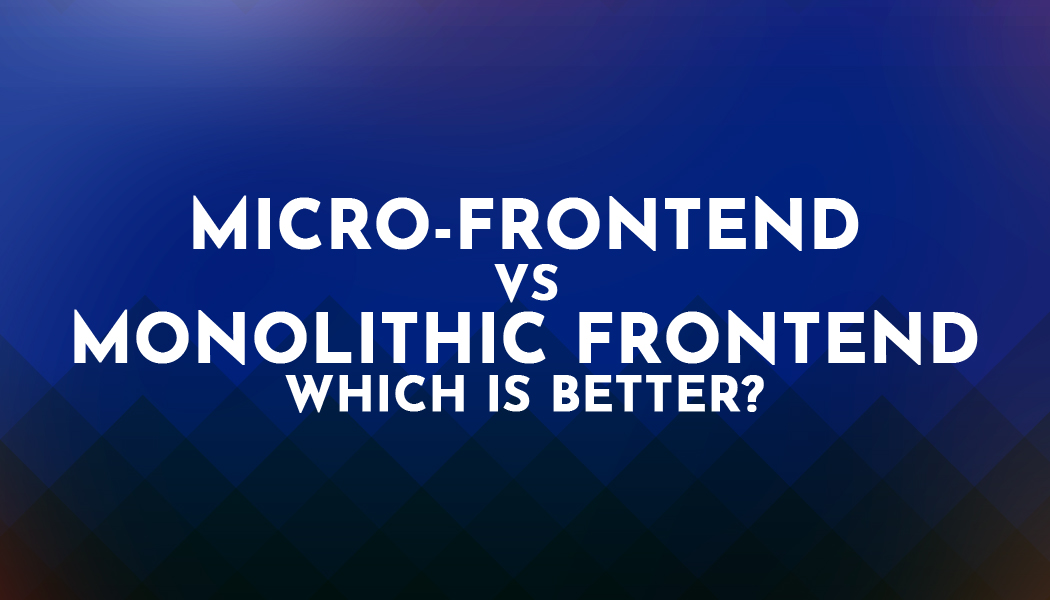Micro-frontend vs. Monolithic Frontend: Which is Better?
Micro front-end architecture has gained significant traction and is a highly in-demand front-end development approach. CTOs worldwide are adopting this approach due to the stability it brings to their organizations, while developers appreciate its increased autonomy.
As businesses grow, front-end challenges can arise despite having an efficient back-end. To overcome these challenges, breaking the front-end into smaller, more manageable parts can improve efficiency and enhance the user experience.
Are you curious about the benefits of micro-frontend architecture and monolithic architecture, but don't know where to start? Look no further! In this article, we will explore the advantages of both approaches and help you decide which one is right for your project. Before we dive into the benefits, let's first get a clear understanding of What is Micro-frontend Architecture and how it differs from the monolithic architecture.
What is Micro-frontend Architecture?
Micro-frontend architecture is an approach to designing front-end applications by breaking them down into smaller, independent parts that can be developed, tested, and deployed separately. This approach simplifies front-end development, improves efficiency, and enhances the user experience.
It allows teams to work more independently, reduces the risk of bugs and conflicts, and makes it easier to maintain and scale the application over time. Essentially, it's a way to make front-end development more modular and flexible.
What is Monolithic Architecture?
Monolithic architecture is a conventional front-end development approach that differs from micro-frontend architecture. In this method, the entire application is treated as a single entity, which means that all features, components, and functionalities are interconnected and interdependent, resulting in tightly coupled code.
This can make the application challenging to scale, maintain, and modify over time. In contrast to micro-frontend architecture, monolithic architecture does not break down the application into smaller, independent parts and instead relies on a single, monolithic codebase.
Advantages of Micro-frontend Architecture
Design and development flexibility: The micro-frontend architecture offers a high degree of flexibility by not being tied to any particular technology stack. This feature allows different teams with diverse needs to utilize it effectively. When team members feel more invested in the project, it enhances their decision-making abilities, reduces development time, and enables the delivery of more valuable features.
Different code bases: The micro-frontend framework simplifies code management and updates by dividing large code blocks into smaller, more manageable pieces. This feature is advantageous for promoting technology independence among teams and micro apps. Separating each team's code ensures more efficient development, testing, and deployment cycles.
Favors native browser over custom APIs: When developing a web application, it's essential to take into account the user's browser, as it can have a significant impact on the app's performance. The micro-frontend architecture offers a distinct advantage in this regard, as communication between components relies on browser events instead of APIs. This makes managing and maintaining the application much more straightforward.
Advantages of Monolithic Architecture
Continuous development is more straightforward: Monolithic design allows for easy expansion and monitoring without worrying about delays or issues from dealing with multiple components.
Easiness of debugging: Debugging is straightforward since all the code is in one place, making it easy to identify and fix issues by following the request flow.
Early application phases are inexpensive: Assembling all source code into a single deployment unit reduces infrastructure and development overhead costs.
Conclusion
In conclusion, micro-frontend architecture offers several benefits to front-end development, including design and development flexibility, separate code bases, and favoring native browsers over custom APIs. It allows teams to work independently, reduces the risk of bugs and conflicts, and makes it easier to maintain and scale applications over time.
On the other hand, the monolithic architecture can simplify continuous development, make debugging straightforward, and reduce infrastructure and development overhead costs during the early phases of application development.
Ultimately, the choice between the two approaches depends on the organization's and the project's specific needs. However, given the increased demand for flexible and scalable front-end solutions, it is evident that micro-frontend architecture is a highly viable option for businesses that want to keep up with the rapidly evolving digital landscape.




